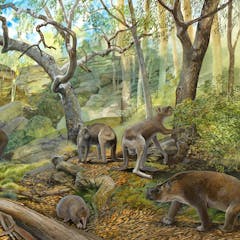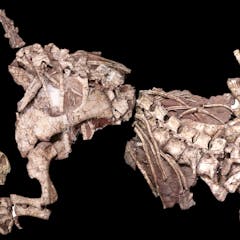
Artikel-artikel mengenai Palaeontology
Menampilkan 1 - 20 dari 186 artikel

A 500-million-year-old find reveals previously unknown features of the sea creatures responsible for some of palaeontology’s most recognisable fossils.

Musankwa is only the fourth dinosaur to be named from Zimbabwe.

In 2021 a former avocado farmer discovered the most complete pterosaur skeleton ever found in Australia – and new research shows it represents a previously unknown species.

Understanding more about feathers could change the way we think about dinosaurs.

Starfish reproduce by splitting in two. A new fossil reveals how ancient this ability is.

The fossil record suggests Australia may be much wetter, and look far different, in centuries and millenia to come.

Experts say the ‘reimagining’ of the South Australian Museum will destroy its crucial contributions to science.

Ichthyosaurs were the last giant reptiles to rule our oceans.

The scarcity of bat fossils is more than a palaeontological puzzle: it has implications for bat conservation strategies today.

Some extinct kangaroos may barely have hopped at all.

The origin date for flowers is a source of debate among scientists – but a new approach may help bring clarity to the question.

By examining fossilized bone tissue, a new study finds rapid growth was an asset for survivors of the Great Dying 250 million years ago, Earth’s largest mass extinction event.

Horse fossils are abundant and widespread across North America. Scientists often use their long history to illustrate how species evolve in response to a changing environment.

If you love learning about dinosaurs don’t let crowdpleasers like the T Rex distract you from the fascinating birdlife that once roamed the Earth.

Some of these giant vegetarians were as tall as a 3-story building. Microscopic analysis of their teeth, bones and eggshells reveals how they grew, what they ate and even their body temperature.

A lizard fossil that was thought to be the best preserved ever has turned out to have fake skin.

The Isle of Skye has a rich palaeontological heritage, so perhaps it’s no surprise scientists made an important discovery there.

What happened to the three-metre tall apes that once lived alongside orangutans? A new study suggests they were too slow to adapt to a changing world.

Some time between 1100 and 1700 AD, a Massospondylus bone was discovered and carried to a rock shelter in Lesotho.

Impress your niece or nephew with these T rex facts.
